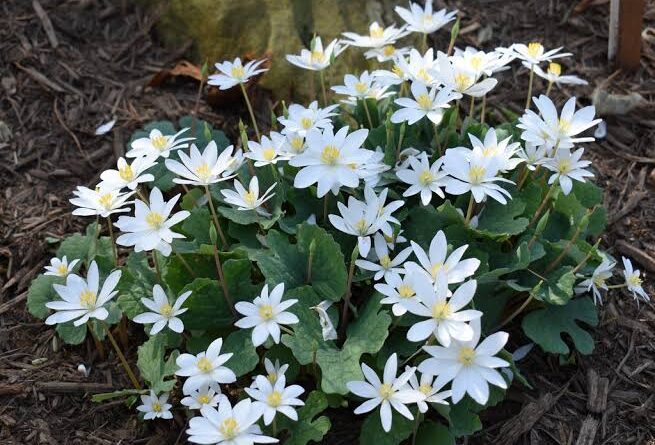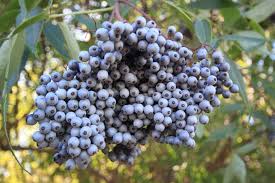10 Medicinal Health Benefits of Bloodroot (Sanguinaria Canadensis)
Bloodroot (Sanguinaria canadensis) is a perennial flowering plant native to North America, particularly regions of the eastern United States and Canada. Known for its vibrant white flowers and characteristic red-orange sap, bloodroot has been a staple of traditional medicine among indigenous communities and herbalists for centuries.
Its unique appearance and various chemical compounds make it a subject of interest in both traditional and modern herbal medicine. Bloodroot belongs to the Papaveraceae family and is characterized by its lobed leaves and white, eight-petaled flowers that usually appear in early spring.
The name “bloodroot” comes from the reddish-orange sap found in its rhizomes, which has been used as a natural dye and for medicinal purposes. The plant grows in moist, rich woodland areas and prefers partial shade.
Bloodroot has been traditionally used for a range of health issues due to its potentially beneficial properties. Its primary active compounds include alkaloids such as sanguinarine, chelerythrine, and berberine. These alkaloids are believed to contribute to its various medicinal effects.
Bloodroot has been utilized topically for its potential effects on skin health. It’s often found in salves, ointments, and pastes for treating various skin conditions like warts, fungal infections, and skin tags. However, caution is advised as the sap can be corrosive and cause irritation if not properly diluted.
The alkaloid sanguinarine found in bloodroot has been studied for its potential antibacterial and anti-inflammatory properties. This has led to its use in natural toothpaste and mouthwash formulations for promoting oral health and reducing plaque formation.
Some studies suggest that bloodroot may possess antioxidant and anti-inflammatory properties, which could have potential benefits for overall health and well-being. However, more research is needed to fully understand the extent of these effects.
Cancer Research Certain compounds present in bloodroot, particularly sanguinarine, have attracted interest in the field of cancer research. Some studies have explored its potential as an anticancer agent due to its ability to induce apoptosis (cell death) in certain cancer cells.
However, this area of research is still in its early stages and requires further investigation. Traditional and Contemporary Use Bloodroot has been a part of traditional medicine practices among various indigenous communities in North America. Native American tribes used it for skin conditions, respiratory issues, and as a ritualistic dye.
In modern times, bloodroot is often used in alternative and complementary medicine practices. It’s important to note that the use of bloodroot should be approached with caution due to its potentially toxic nature, especially when used improperly or in excessive amounts.
The Botanical Description of Bloodroot
1. Life: Bloodroot, scientifically known as Sanguinaria canadensis, is a perennial herbaceous plant belonging to the Papaveraceae family. This fascinating plant typically grows 20 to 30 centimeters in height and emerges from an underground rhizome. Bloodroot is named for its thick, red-orange sap that oozes from the roots and stems when cut, resembling the appearance of blood.
2. Leaves: The basal leaves of Bloodroot are large, round, and deeply lobed, creating an umbrella-like structure. The leaves are approximately 10 to 20 centimeters in diameter and are distinctive due to their deep green color. The lobed pattern adds an ornamental aspect to the plant, contributing to its visual appeal.
3. Flowers: Bloodroot produces solitary flowers, each with eight to twelve delicate white petals. The flowers, which bloom in early spring, are supported by a single stem arising directly from the rhizome. The contrast between the white petals and the yellow center creates a visually striking display in woodland settings.
4. Rhizome: The rhizome of Bloodroot is a critical part of its structure, serving as the storage organ for nutrients. The rhizome produces new shoots each year, contributing to the perennial nature of the plant. It is from the rhizome that the plant emerges, showcasing the cyclical and regenerative aspects of Bloodroot.
The Geographic Distribution of Bloodroot
1. Native Range: Bloodroot is native to eastern North America, primarily found in the United States and Canada. Its natural habitat includes deciduous forests, wooded slopes, and moist areas where it thrives in the well-drained, rich soils prevalent in these regions.
2. Habitat Preferences: Within its native range, Bloodroot displays a preference for shady environments. Woodlands, especially those with a mix of deciduous trees, provide the ideal conditions for the growth of Bloodroot. The plant often carpets the forest floor in early spring, creating a visually enchanting scene.
3. Cultivation: Bloodroot has found a place in gardens beyond its native range, where it is cultivated for its aesthetic appeal and unique characteristics. When cultivated, it can be grown in shaded garden beds, providing a burst of early spring blooms. However, care must be taken to replicate its natural habitat for optimal growth.
The Chemical Composition of Bloodroot
1. Sanguinarine: One of the key compounds found in Bloodroot is sanguinarine, an alkaloid with recognized antimicrobial properties. Sanguinarine has been studied for its potential applications in oral health products due to its ability to combat certain bacteria.
2. Benzylisoquinoline Alkaloids: Bloodroot contains a variety of benzylisoquinoline alkaloids, which contribute to its medicinal properties. These alkaloids have been explored for their potential anti-inflammatory and anticancer effects, although further research is ongoing to fully understand their mechanisms.
3. Tannins: Tannins are present in Bloodroot, contributing to its astringent properties. Tannins have been traditionally used for their ability to tighten and tone tissues, and they play a role in the medicinal uses associated with Bloodroot.
4. Flavonoids: Flavonoids, known for their antioxidant properties, are also found in Bloodroot. These compounds contribute to the plant’s ability to combat oxidative stress and may play a role in its overall health benefits.
Read Also: Significance and Uses of Single Roses
The Medicinal Health Benefits of Bloodroot (Sanguinaria Canadensis)

1. Skin Health: Bloodroot has been used topically to address various skin issues. Its antimicrobial properties may help with fungal infections like athlete’s foot. A bloodroot-based salve might be applied to the affected area to reduce itching and irritation.
2. Oral Health: The alkaloid sanguinarine in bloodroot can help fight bacteria, making it useful for oral health. Toothpaste with bloodroot extract might help reduce plaque buildup and gingivitis, promoting healthier gums and teeth.
3. Wart Removal: Bloodroot’s corrosive nature makes it effective for wart removal. A bloodroot paste could be applied to warts, gradually causing them to slough off. However, care must be taken to avoid excessive use to prevent skin damage.
4. Anti-inflammatory Effects: Bloodroot’s anti-inflammatory properties might help soothe inflamed skin conditions. A bloodroot-based cream could alleviate redness and discomfort associated with eczema or psoriasis.
5. Antioxidant Support: Bloodroot’s antioxidants may combat free radicals, aiding overall health. Consuming bloodroot tea could potentially contribute to the body’s antioxidant defenses.
6. Respiratory Relief: Traditional use includes bloodroot for respiratory issues. Bloodroot-based preparations might be used to alleviate symptoms of a cold or congestion, providing relief for the respiratory system.
7. Potential Cancer Research: Bloodroot’s compounds, such as sanguinarine, are being studied for their potential in cancer treatment. Researchers are exploring its ability to induce apoptosis in cancer cells, which could eventually lead to novel treatments.
8. Blood Circulation: Bloodroot might promote blood circulation due to its vasodilatory properties. Consuming bloodroot as part of a controlled herbal formula could potentially benefit individuals with poor circulation.
9. Cardiovascular Health: Some components of bloodroot, like berberine, have been linked to cardiovascular benefits. Bloodroot supplements could play a role in managing cholesterol levels and supporting heart health.
10. Menstrual Health: Bloodroot’s traditional use includes aiding menstrual discomfort. Herbal preparations might help alleviate cramps and discomfort associated with menstruation.
The Methods of Usage to Achieve the Provided Medicinal Health Benefits of Bloodroot (Sanguinaria Canadensis)
Bloodroot (Sanguinaria canadensis) offers several potential medicinal benefits, and its usage methods vary based on the desired health outcome.
Here’s an in-depth explanation of how to use bloodroot medicinal plant to achieve specific health benefits:
1. Skin Health: Create a bloodroot paste by combining bloodroot powder with a neutral base like petroleum jelly. Apply a small amount to the affected area. Cover with a bandage to prevent the paste from drying too quickly.
For an athlete’s foot, apply the bloodroot paste to the affected areas on the feet. The antimicrobial properties of bloodroot can help combat fungal growth and reduce itching.
2. Oral Health: Look for toothpaste or mouthwash products containing bloodroot extract or sanguinarine. Follow the manufacturer’s instructions for usage. Use a bloodroot-based toothpaste or mouthwash daily as part of your oral hygiene routine. The sanguinarine in bloodroot may help reduce plaque formation and promote healthier gums.
3. Wart Removal: Apply a small amount of bloodroot salve or paste directly onto the wart. Cover it with a bandage and leave it on for a specific period (as directed). Monitor for any adverse reactions. Gently apply bloodroot paste onto the wart and cover it with a bandage. Over time, the wart may gradually diminish in size as the bloodroot paste encourages the outer layers to peel off.
4. Anti-inflammatory Effects: Apply a bloodroot-infused cream or ointment to the affected area, gently massaging it in. Use a bloodroot cream on areas affected by eczema. The anti-inflammatory properties of bloodroot could help reduce redness and itching associated with the condition.
5. Antioxidant Support: Prepare bloodroot tea by steeping dried bloodroot powder or fresh bloodroot slices in hot water for about 10 minutes. Strain before drinking. Consume bloodroot tea as part of a balanced diet to potentially benefit from its antioxidant properties. This could contribute to overall health and well-being.
6. Respiratory Relief: Prepare a steam inhalation by adding a small amount of dried bloodroot to a bowl of hot water. Inhale the steam while covering your head with a towel. When dealing with congestion due to a cold, inhale bloodroot-infused steam to potentially ease respiratory discomfort and congestion.
7. Potential Cancer Research: This is a potential area of future medical research. If research progresses, methods might include developing targeted medications based on bloodroot compounds for specific cancer types.
8. Blood Circulation: Consult an experienced herbalist for guidance on bloodroot usage in controlled herbal formulas tailored to your individual health needs. If an herbalist recommends bloodroot as part of a formula, follow their instructions to potentially support better blood circulation.
9. Cardiovascular Health: Consider using bloodroot supplements, which can be found in various forms such as capsules or extracts. Follow the recommended dosage on the product label. In consultation with a healthcare professional, use bloodroot supplements to potentially assist in maintaining healthy cholesterol levels and supporting cardiovascular health.
10. Menstrual Health: Prepare bloodroot tea using dried bloodroot or consult a herbalist for advice on usage in targeted herbal blends. If experiencing menstrual discomfort, consult a herbalist to determine if bloodroot-infused teas or herbal blends might help alleviate cramps and discomfort.
Read Also: Dutch Iris Flowers (Iris x Hollandica): All You Need To Know About
The Scientific Research and Studies of Bloodroot (Sanguinaria canadensis)

1. Medicinal Properties and Alkaloids: In-depth analysis of the medicinal properties of Bloodroot, focusing on its alkaloid content, particularly sanguinarine, and its potential applications in traditional and modern medicine.
2. Dermatological Uses: Scientific investigations into the dermatological uses of Bloodroot, including studies on its effectiveness in treating skin conditions, warts, and other dermatological issues.
3. Anti-Cancer Potential: Research on the anti-cancer potential of Bloodroot, exploring its effects on cancer cells and its role in cancer prevention or treatment, especially in the context of skin cancers.
4. Toxicology and Safety: Studies assessing the toxicology and safety profile of Bloodroot, considering potential side effects and dosage guidelines to ensure its safe use in various applications.
5. Ecological Impact and Conservation: Scientific analysis of the ecological impact of harvesting Bloodroot, along with studies on its conservation status and strategies to ensure sustainable harvesting practices.
6. Traditional Uses in Native American Medicine: Exploration of the traditional uses of Bloodroot in Native American medicine, providing insights into its cultural significance and historical applications in indigenous healing practices.
The Side Effects of Using Bloodroot Medicinal Plant
Using bloodroot (Sanguinaria canadensis) for medicinal purposes can lead to various side effects if not used properly or in excessive amounts.
Some of the potential side effects associated with using bloodroot medicinal plant include:
1. Skin Irritation: Direct application of bloodroot paste or salve on the skin can cause irritation, redness, and even burns. The corrosive nature of bloodroot’s compounds can harm healthy skin if not used cautiously.
2. Allergic Reactions: Some individuals may be allergic to bloodroot or its components. Allergic reactions can manifest as itching, swelling, hives, or even more severe symptoms like difficulty breathing. Always perform a patch test before using bloodroot topically.
3. Skin Discoloration: Prolonged use of bloodroot products can lead to temporary or permanent skin discoloration, especially in the area where the product was applied. This is more likely to occur with higher concentrations of bloodroot.
4. Gastrointestinal Upset: Consuming bloodroot orally can lead to nausea, vomiting, and stomach upset due to its alkaloid content. Internal use of bloodroot is generally discouraged due to its potential toxic effects.
5. Damage to Healthy Tissue: The corrosive properties of bloodroot can inadvertently damage healthy tissue if not used with care. This is especially true when using bloodroot for wart removal or other skin issues.
6. Interaction with Medications: Bloodroot’s compounds may interact with certain medications or other herbal supplements. Consult a healthcare professional before using bloodroot if you are on any other medications.
7. Pregnancy and Breastfeeding Concerns: Bloodroot should be avoided during pregnancy and breastfeeding. The potential effects on the fetus or infant are not well understood, and it’s best to err on the side of caution.
8. Liver and Kidney Concerns: The alkaloids in bloodroot may impact liver and kidney function, particularly if used internally or in large amounts. Individuals with preexisting liver or kidney conditions should avoid bloodroot usage.
9. Eye Irritation: Contact with bloodroot sap or products near the eyes can cause severe irritation and damage to the sensitive eye tissues. Care should be taken to avoid contact with the eyes.
10. Carcinogenic Potential: Some studies have suggested a potential link between bloodroot and an increased risk of oral cancer due to its sanguinarine content. This emphasizes the importance of careful use and avoiding internal consumption.
The Safety Precautions and Recommendations In Using Bloodroot Medicinal Plant
1. Consultation with Healthcare Professional: Before incorporating Bloodroot into any medicinal or health regimen, it is crucial to consult with a qualified healthcare professional.
This is particularly important for individuals with pre-existing medical conditions, those on prescribed medications, or pregnant and lactating individuals. A healthcare provider can provide personalized advice based on an individual’s health status.
2. Dosage Guidelines: Adhering to recommended dosage guidelines is essential when using Bloodroot. Excessive consumption may lead to adverse effects, and the concentration of active compounds can vary among different preparations.
Following the suggested dosage on product labels or as advised by a healthcare professional ensures safe use.
3. Avoiding Prolonged Use: Prolonged and continuous use of Bloodroot is generally not recommended. Extended use may lead to tolerance or adverse reactions. It is advisable to use Bloodroot for specific periods as directed by a healthcare provider to prevent potential complications.
4. Allergy Testing: Before using Bloodroot topically or internally, it is advisable to conduct an allergy test. Apply a small amount of the product to a small patch of skin and monitor for any allergic reactions. If redness, itching, or irritation occurs, discontinue use immediately and seek medical advice.
5. Topical Application Precautions: When using Bloodroot in topical applications, such as creams or salves, it is important to avoid applying it to broken or irritated skin. Additionally, the application should be limited to the recommended area to prevent unnecessary exposure.
6. Storage and Handling: Proper storage of Bloodroot products is essential for maintaining their efficacy and safety. Store them in a cool, dry place, away from direct sunlight and out of reach of children. Follow any specific storage instructions provided on product labels.
7. Awareness of Side Effects: While Bloodroot has been used traditionally for various health purposes, it can have side effects. Common side effects may include nausea, vomiting, and dizziness. If any adverse reactions occur, it is important to discontinue use and seek medical attention.
FAQs About Bloodroot Medicinal Plant
1. Can Bloodroot Cure Cancer?
No, there is no conclusive scientific evidence supporting the use of Bloodroot as a standalone cure for cancer. While certain compounds in Bloodroot, such as sanguinarine, have shown anti-cancer properties in laboratory studies, their efficacy and safety in humans are not well-established. It is crucial to rely on proven medical treatments for cancer under the guidance of healthcare professionals.
2. Is Bloodroot Safe for Skin Conditions?
Bloodroot has been historically used for skin conditions, but its safety and effectiveness can vary. It is advisable to consult with a dermatologist or healthcare professional before using Bloodroot for skin issues. Patch testing is recommended to check for any adverse reactions.
3. Can Pregnant Women Use Bloodroot Products?
Pregnant women should exercise caution when considering the use of Bloodroot products. The safety of Bloodroot during pregnancy is not well-documented, and it is advisable to consult with a healthcare provider before using such products during pregnancy or lactation.
4. How Quickly Can I Expect Results from Bloodroot Products?
The time it takes to see results from Bloodroot products can vary depending on the specific health concern and the individual’s response. Patience is essential, and consistent use as directed is recommended for optimal outcomes. If no improvement is observed, it is advisable to seek professional advice.
5. Can Bloodroot Products Replace Prescription Medications?
Bloodroot products should not be considered as replacements for prescribed medications without consulting a healthcare provider. While Bloodroot may have beneficial properties, it is not a substitute for proven medical treatments. Any adjustments to medication regimens should be done under professional supervision.
Read Also: How to Recycle: A Complete Beginner’s Guide









